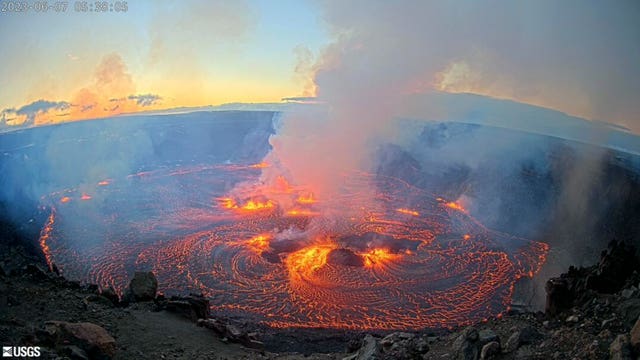
Kilauea, one of the most active volcanoes in the world, began erupting on Wednesday after a three-month pause, displaying spectacular fountains of mesmerising, glowing lava on Hawaii’s Big Island.
The US Geological Survey’s Hawaiian volcano observatory said in a statement that a glow was detected in webcam images from Kilauea’s summit early in the morning, indicating that an eruption was occurring within the Halemaumau crater in the summit caldera.
The images show fissures at the base of the crater generating lava flows on the crater floor’s surface, the observatory said.
Before issuing the eruption notice, the observatory said increased earthquake activity and changes in the patterns of ground deformation at the summit started on Tuesday night, indicating the movement of magma in the subsurface.

“We’re not seeing any signs of activity out on the rift zones right now,” said Mike Zoeller, a geologist with the observatory. “There’s no reason to expect this to transition into a rift eruption that would threaten any communities here on the island with lava flows or anything like that.”
All activity was within a closed area of Hawaii Volcanoes National Park.
“The lava this morning is all confined within … the summit caldera. So plenty of room for it still to produce more without threatening any homes or infrastructure,” said park spokesperson Jessica Ferracane. “So that’s the way we like our eruptions here.”
She said park officials are bracing for crowds to arrive because visitors can see the eruption from many overlooks.
“Kilauea overlook was spectacular this morning,” she said of the vast lava lake. “It was molten red lava. There’s several areas of pretty robust fountaining. It’s just really, really pretty.”
The lava lake, covering the crater floor over lava that remained from previous eruptions, measured about 150 hectares – equivalent to about 210 pitches – at 6am, Mr Zoeller said. It measured about 1,300 metres wide.
A 2018 Kilauea eruption destroyed more than 700 homes.
Before the major 2018 eruption, Kilauea had been erupting since 1983, and streams of lava occasionally covered farms and homes.
During that time, the lava sometimes reached the ocean, causing dramatic interactions with the water.


Why are you making commenting on The National only available to subscribers?
We know there are thousands of National readers who want to debate, argue and go back and forth in the comments section of our stories. We’ve got the most informed readers in Scotland, asking each other the big questions about the future of our country.
Unfortunately, though, these important debates are being spoiled by a vocal minority of trolls who aren’t really interested in the issues, try to derail the conversations, register under fake names, and post vile abuse.
So that’s why we’ve decided to make the ability to comment only available to our paying subscribers. That way, all the trolls who post abuse on our website will have to pay if they want to join the debate – and risk a permanent ban from the account that they subscribe with.
The conversation will go back to what it should be about – people who care passionately about the issues, but disagree constructively on what we should do about them. Let’s get that debate started!
Callum Baird, Editor of The National
Comments: Our rules
We want our comments to be a lively and valuable part of our community - a place where readers can debate and engage with the most important local issues. The ability to comment on our stories is a privilege, not a right, however, and that privilege may be withdrawn if it is abused or misused.
Please report any comments that break our rules.
Read the rules here